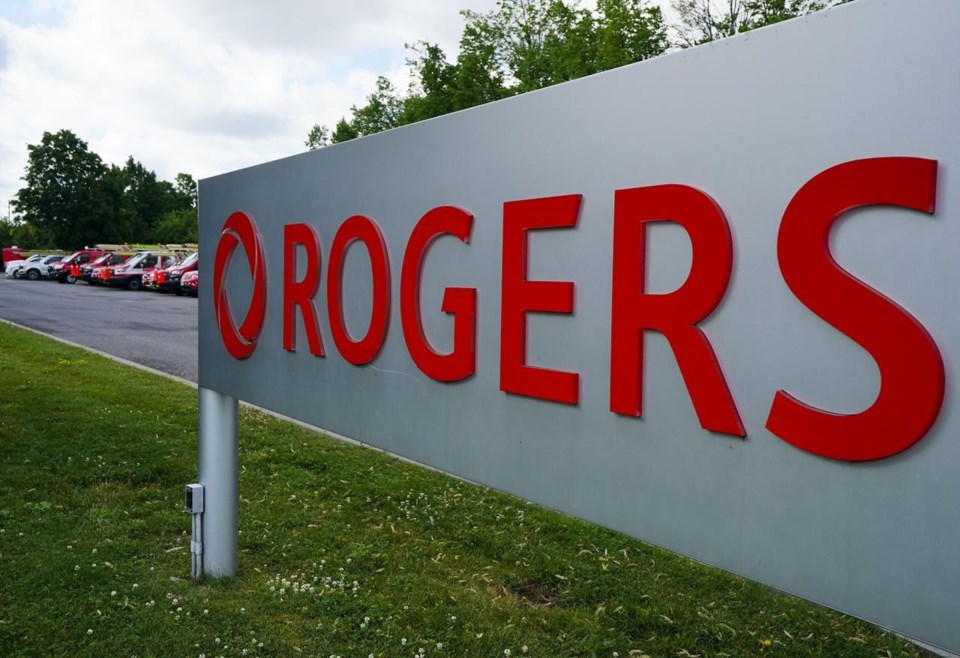TORONTO — The chief executive of Rogers Communications Inc said the company is well ahead of schedule in its plans to cut costs around half a year into its $26-billion merger with Shaw.
Rogers, which closed its takeover of Shaw in early April after receiving final regulatory approval from Ottawa, has sought to cut duplication costs as the companies integrate with one another.
"Impressively at the six-month mark, we are tracking six months ahead of our synergy targets and deleveraging plans," Rogers president and CEO Tony Staffieri told analysts Thursday morning during the company's third-quarter earnings call.
"We've consolidated our retail footprint, rebranded our corporate retail stores and started selling both wireless and residential services in our retail channels. Importantly, we have largely integrated the two teams and we are executing with one clear focus and plan."
Chief financial officer Glenn Brandt said the company saw "significant" cost savings of approximately $140 million during its third quarter, as Rogers mostly completed its process of combining Shaw's departments and employees within its own structures.
That builds on its savings of $48 million in the second quarter, bringing the year-to-date total to $188 million heading into the final three months of 2023.
Rogers had hoped to find $200 million in savings from the merger by year-end.
"We now expect over $360 million in synergies to be realized in calendar 2023, which is 80 per cent higher than previously guided," said Brandt.
"We are seeing strong revenue synergies with our cable and wireless growth in the west."
The company began offering voluntary departure packages to some employees in July as it worked to integrate with Shaw. It said in an internal memo at the time that eligible employees who could apply to receive a voluntary package through the program included “most corporate and line of business employees” up to the senior director level of the company.
Rogers also confirmed that month that “a small percentage” of employees had left the company involuntarily since the Shaw merger, but did not say how many were affected by either the voluntary departure program or other cuts.
Brandt said Rogers is still targeting total annual cost savings of around $1 billion from the Shaw merger — a figure Rogers originally said it anticipated when it first announced its deal to buy Shaw in 2021.
Its focus will now turn to finding efficiencies through contract negotiations with vendors and cutting down on media content costs.
"We are leaning in on those," said Brandt. "I expect that those will come to plan, at least on pace, if not also being maybe a little bit ahead."
Last month, Rogers announced it was closing its CityNews Ottawa radio station and laying off close to 10 newsroom staff, citing dwindling audiences and regulatory challenges.
The company reported a net loss in its latest quarter as it was hit by a charge related to one of its joint venture investments. The cable and wireless company said it lost $99 million or 20 cents per diluted share for the quarter ended Sept. 30 compared with a profit of $371 million or 71 cents per diluted share a year ago.
The results in the most recent quarter included a $422-million loss on an obligation to purchase at fair value the non-controlling interest in one of its joint ventures' investments.
On an adjusted basis, Rogers said it earned $1.27 per diluted share in its most recent quarter, up from an adjusted profit of 84 cents per diluted share a year earlier.
Revenue in the company's third quarter totalled $5.09 billion, up from $3.74 billion in the same quarter last year.
Rogers said its net increase in mobile phone subscribers totalled 261,000 for the three-month period, its best quarterly result ever, including 225,000 postpaid mobile phone net adds — up 61 per cent from the 164,000 recorded the same period last year.
The company credited the gains to "sales execution and customer satisfaction in a growing Canadian market."
Staffieri said that as Rogers and Shaw continue to integrate, the combined company is focused on two main messages.
"Let's keep it simple for the customer. Let's keep it simple for us," he said.
"We have a very clear focus on the things that are going to matter most and we try not to overload our execution agenda … As I look to our performance in this fourth quarter, now that we're midway through, we continue to see good continued momentum on the synergy execution."
R–°¿∂ ”∆µ Capital Markets analyst Drew McReynolds said Rogers delivered "strong" results that beat analysts' forecast, "driven mainly by wireless."
"Given strong results, an acceleration in the timing of realized synergies and the reiteration of 2023 guidance, we view results as positive for the shares at current levels," he said in a note.
Rogers' monthly churn for net postpaid mobile phone subscribers was 1.08 per cent, up from 0.97 per cent during its previous third quarter.
Rogers' mobile phone average monthly revenue per user was $58.83, marking a 3.5 per cent increase from the third quarter of the prior year. It attributed the year-over-year difference to credits doled out to customers last year in the wake of its July 2022 network outage.
Its net increase in internet subscribers amounted to 18,000 for the quarter, which was up 12,000 year-over-year.
This report by The Canadian Press was first published Nov. 9, 2023.
Companies in this story: (TSX:RCI.B)
Sammy Hudes, The Canadian Press




